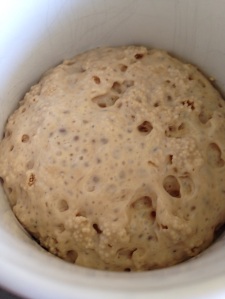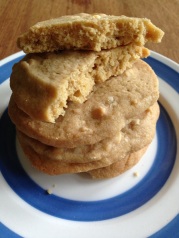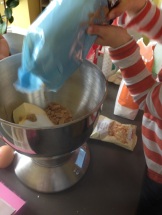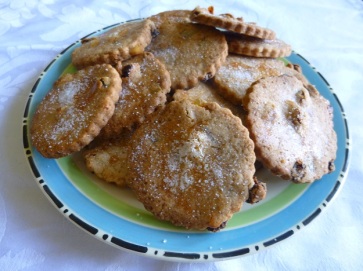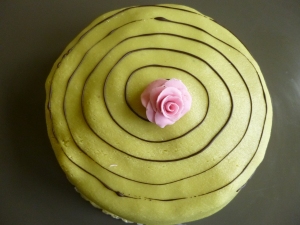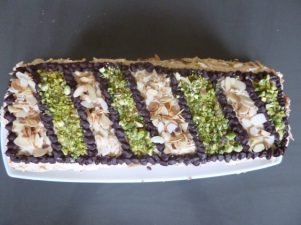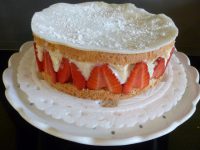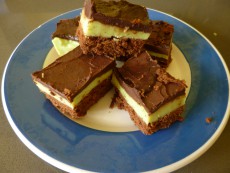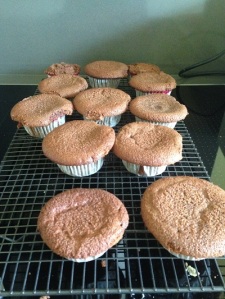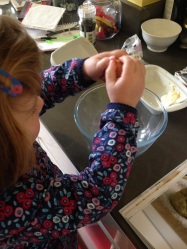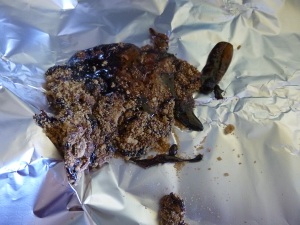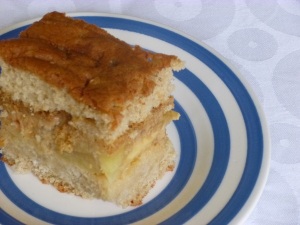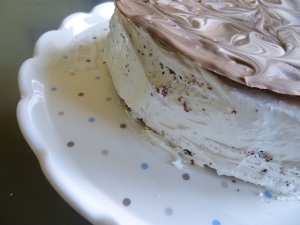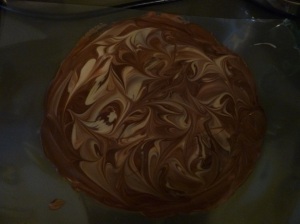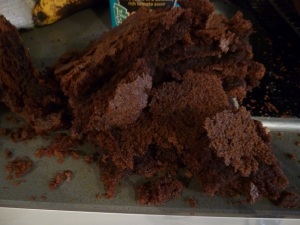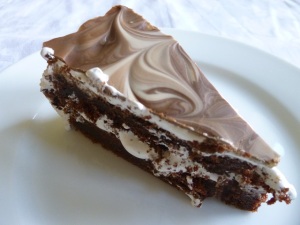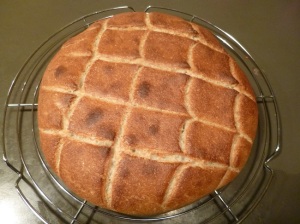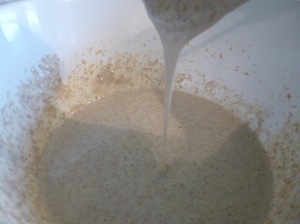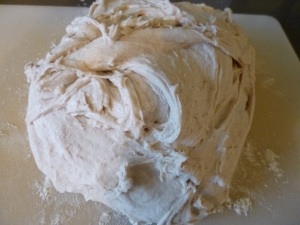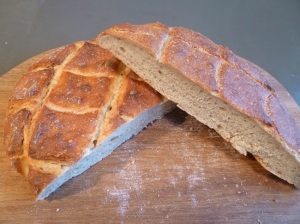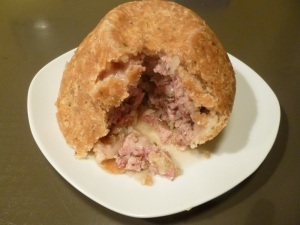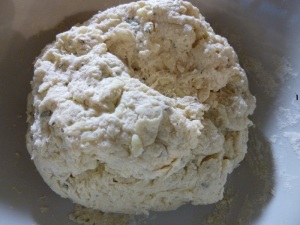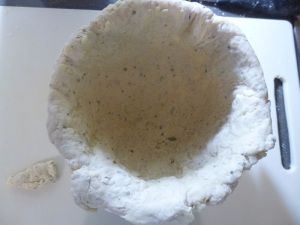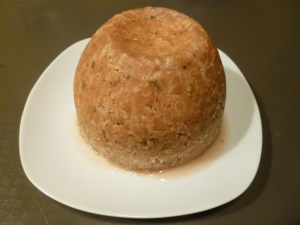It seems like a very long time since I said I would bake a kougelhopf to try out my new bundt tin. It is. I’ve been well and truly side-tracked by things like half-term and a chronic attack of I-really-can’t-be-bothereditis. I think the rain brought this on, and the fact that I bought a new face cream that’s advertised by Helen Mirren (I don’t have anything against her at all, it’s just that she’s quite a bit older than me and I hadn’t quite prepared myself for moving up the skin cream age bracket just yet). I also had a moment where I seriously considered buying some of that caffeine shampoo that’s advertised to the forty-something woman in a whisper. No wonder the sofa and back-to-back episodes of Home and Away seemed more appealing than a day in the kitchen.
Anyway, I did eventually make a kougelhopf. Well, I tried to. I didn’t end up with a proper one, just a heavy, ring-shaped cake/bread kind of thing. It did get eaten though, and I haven’t been put off having a second go (although not just yet).
 I know where I went wrong. I’ve attempted several enriched dough breads/cakes for Let’s Bake the Books and I’ve had more failures than successes. I made three batches of hot cross buns, for example, and none of them turned out tasting like hot cross buns should. I had better luck with a brioche Christmas garland and, to be honest, by the time I’d tackled a savarin (for the second time), I thought enriched dough would no longer pose any problems.
I know where I went wrong. I’ve attempted several enriched dough breads/cakes for Let’s Bake the Books and I’ve had more failures than successes. I made three batches of hot cross buns, for example, and none of them turned out tasting like hot cross buns should. I had better luck with a brioche Christmas garland and, to be honest, by the time I’d tackled a savarin (for the second time), I thought enriched dough would no longer pose any problems.
A kougelhopf you say? I could make one with my eyes closed.
I could have made a successful kougelhopf (I hope), but I was lacking in two key ingredients. Time and patience (actually, I don’t think I can honestly blame lack of time – I’m sure, if I was more organised, I’d have plenty. It was lack of patience that did it).
I used a recipe from Edd Kimber’s Patisserie Made Simple. The bundt tin I was using was a small one. I agonised for a few minutes about whether I should make half the recipe, two-thirds, three-quarters… I decided that the best thing to do would be to go with half. It was the easiest mathematically and my maths has never been great. Maths combined with complicated dough making and I’d be done for.
Edd Kimber’s Kougelhopf recipe is a two-dayer. On day one, I made the dough.
First, I activated my yeast – the recipe uses fast-action dried yeast – I do have some but, to be honest, I’ve had my best enriched dough results when I’ve used the stuff you have to activate first. I dissolved my yeast in some milk with a bit of sugar and left if to bloom. Bloom it did. Here it is.
In the meantime, I heated some raisins in a pan with a mixture of rum and water until the liquid had been absorbed. These would go into the dough once it had been mixed.
I added my yeast to a combination of plain and strong white bread flour, caster sugar and salt and mixed in the KitchenAid with the dough hook. I added eggs and mixed – the recipe doesn’t give you the option of hand mixing (which I never do, but always feel that I should – good on you Edd Kimber for going straight to the food mixer).
This stage of the kneading process, says the recipe, should take at least ten minutes from when the dough first forms, and that it’s ready when it is smooth and elastic. I’m never quite sure when I get to that smooth and elastic stage. I think my mixture could have done with a bit more kneading but I was a bit pushed for time, so I stopped at the prescribed ten minutes. I kept the KitchenAid running as I added room temperature butter a little bit at a time and then kneaded as per the recipe for another fifteen minutes.
This time, the test for whether the dough had been kneaded enough was that it shouldn’t stick to the side of the bowl. I had a bit of a problem here. The dough would leave the side of the bowl and stick around the dough hook, but then it would migrate back into the bowl, sit there on the side for a while, then cling to the dough hook again. This kept happening. I had no idea whether the dough was ready or not.
I added raisins and orange zest to the dough, gave it another short mix, put it into a greased bowl, covered the bowl with clingfilm, and put it into the fridge to rise slowly overnight. Day one complete.
The first step on Day Two was to grease my bundt tin and sprinkle almonds into the bottom. Easy. Then I was supposed to take the dough from the fridge, give it a quick press, form it into a round, make a hole in the middle and put it into the tin.
I took my dough out of the fridge and found that a thick skin had formed on the top. Should I have pressed the clingfilm onto the surface of the dough to stop this? This is what you have to do with custard. I checked the recipe. It wasn’t particularly clear, but it hadn’t said anything about the dough developing an elephant hide overnight. I took it out of the fridge. It was too cold to do anything with. I couldn’t press it, I couldn’t make it into a round, or make a hole in the middle of it. I think I should have let the dough come up to room temperature, or at least warm up a little bit. As I’ve said though, I didn’t display much patience with my kougelhopf dough and I fought it into the tin, skin and all, and flung it into a warm place to prove.
Now, the recipe says that the dough should double in size, and that this should take about two hours. You can tell when it’s ready when you press it with a lightly floured finger and the dough springs back slowly. I forgot to put flour on my finger so, when I did the test, I came away with a very sticky dough-covered finger and I wasn’t sure whether the spring back had been slow enough. It was slow enough for me, I decided. It had to be because, if it wasn’t, I wouldn’t be able to put it into the oven before I had to leave for school pick-up and that would mean that it would be another few hours before I’d have the chance to bake it.
I put the kougelhopf into the oven at 160° fan for thirty minutes (the recipe says thirty-five, but I was concerned that, since I was only baking half of the recipe, my cooking time would, perhaps, be shorter. The top of the kougelhopf was also turning from the golden brown it should be to dark brown).
I left the cake in the tin for five minutes and then turned it onto a wire rack. Some of it stayed in the bundt tin, but I did manage to get it out stick it onto the top of the cake (sort of). I was supposed to brush melted butter over the kougelhopf, but I hadn’t read this bit of the recipe, so I dotted some unmelted butter around the top and had a quick look around the kitchen drawers for my pastry brush. I didn’t find it (although I did find a pair of scissors that I’d been looking for for weeks), so I used a knife to spread the butter around a bit and, once the kougelhopf had cooled down, I dusted it with icing sugar (which covered up my multitude of mistakes).
As I said, what I ended up with wasn’t a kougelhopf. It hadn’t risen half as much as the one in the picture in Patisserie Made Simple, and the dough was dense and chewy (although not inedible). The poor thing suffered from lack of love and attention on my part. I think the moral of the kougelhopf is that it should only be attempted where time isn’t an issue and, if you think it’s passed the “is the dough kneaded enough?” and the “has the dough proved enough?” tests give it a few more minutes, just to make sure.

